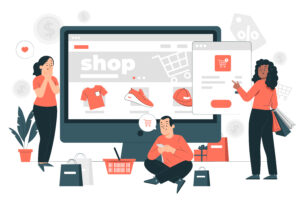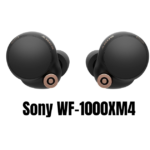
The process of Ecommerce website development is like building a virtual storefront that never closes. It’s a dynamic process that requires a blend of technical expertise and creative flair. From the moment you conceive of your online store to the day you launch it, you’re constantly tweaking and fine-tuning, making sure that every aspect of your website is optimized for success. Whether it’s designing a user-friendly interface, developing a secure payment gateway, or integrating the latest marketing tools, every decision you make has an impact on your bottom line. But with the right team of developers and designers, the process of ecommerce website development can be exhilarating, as you watch your vision take shape before your eyes. It’s a journey full of challenges and rewards, where every obstacle overcome brings you one step closer to your goal: a thriving online business that’s open 24/7, 365 days a year.
E-Commerce Website Development Process
Building an e-commerce website with an affordable custom website design may seem like a daunting task, but it’s easier than you might think. Here are some pointers to get you going:
Choose the Right Platform
Choosing the right platform for ecommerce website development is crucial to the success of your online store. Choosing the best platform for you can be difficult because there are so many possibilities. When considering platforms, it’s important to think about your specific needs and budget. Consider factors such as ease of use, scalability, security, and available features. It’s also important to look at the platform’s community support and user base. A popular platform with a large community of users may offer more resources and support than a lesser-known platform. Additionally, if you require an affordable custom website design, make sure the platform allows for flexibility and customization. Finally, consider the costs associated with each platform, including transaction fees, hosting fees, and any additional features or plugins. By carefully weighing these factors, you can choose the right platform for your ecommerce website development that offers an affordable custom website design.
Define Your Brand
Defining your brand is an essential step when creating an affordable custom website design for your e-commerce website. Your brand is who you are and what makes you stand out from the competitors. To define your brand, start by identifying your target audience and their needs. This will help you create a brand voice and messaging that resonates with your customers. Consider your values, mission, and unique selling proposition. What makes your brand different? What are your core values? What are your goals? Your answers to these questions will help you craft a brand identity that reflects your company’s personality and values. Finally, consider your visual identities, such as your logo, color scheme, typography, and imagery. These elements should be consistent across your website and other marketing materials. By defining your brand, you can create an affordable custom website design that accurately reflects your business and appeals to your target audience.
Keep It Simple
Keeping the ecommerce website development process simple can help you save time and money while still delivering an effective online store. To keep it simple, start by identifying your core features and functionality. Focus on what is essential to your business and customers, and avoid adding unnecessary features that may increase costs and complicate the user experience. Next, choose a platform or framework that is easy to use and customize. This will help you avoid spending time and money on a customized ecommerce website development process. Consider using pre-made templates or themes that can be easily customized to your brand’s style and needs. Finally, prioritize user experience and ease of navigation. Make sure your website’s layout is simple and intuitive, with clear calls to action and a streamlined checkout process. By keeping these principles in mind, you can create an affordable ecommerce website development process that delivers a high-quality online store without breaking the bank.
Use Templates
Using templates for an affordable custom website design is an excellent way to save time and money while still achieving a professional-looking website. There are many templates available for a variety of platforms and frameworks, including WordPress, Shopify, and WooCommerce. Templates typically come with pre-designed layouts, color schemes, and typography, making it easy to customize them to fit your brand’s style and needs. When selecting a template, look for one that closely matches your vision for your affordable custom website design. From there, you can customize the template by adding your content, images, and branding elements. Keep in mind that while templates can be a great starting point, they may not perfectly fit your needs, so be prepared to make adjustments as necessary. You can also work with a designer or developer to further customize your template and ensure that your website stands out from the crowd. By using templates, you can create an affordable custom website design that looks professional and meets your business’s needs.
Hire a Freelancer
Hiring a freelancer for ecommerce website development can be a cost-effective way to get professional expertise without committing to a long-term employee. To find a freelancer, start by researching freelance platforms like Upwork or Freelancer, where you can browse through portfolios, reviews, and ratings to find a qualified candidate. When evaluating candidates, look for experience with the ecommerce website development and familiarity with the platform you’re using. Make sure to communicate your project requirements clearly and discuss timelines and payment terms upfront. Ask for references and samples of their work to ensure they have the skills and experience you need. Additionally, consider setting up a test project to evaluate their skills and compatibility with your team. Keep in mind that hiring a freelancer requires more management on your part, so be prepared to communicate regularly and provide feedback throughout the ecommerce website development process.
Prioritize Usability
Prioritizing usability is critical when creating an affordable custom website design that meets the needs of your customers. Start by defining your target audience and understanding their needs and behaviors. From there, you can design your website’s layout and navigation to be intuitive and user-friendly. Consider using a consistent color scheme, typography, and imagery that aligns with your brand’s style and resonates with your target audience. Make sure your website is optimized for mobile devices, with a responsive design that adapts to different screen sizes. Additionally, simplify your checkout process by minimizing the number of steps required to complete a purchase. Consider implementing features like a guest checkout option, auto-fill fields, and real-time shipping rates to improve the user experience. Finally, test your website’s usability regularly by conducting user testing and gathering feedback from your customers. By prioritizing usability, you can create an affordable custom website design that meets the needs of your customers and drives conversions.
Optimize for Mobile
Optimizing an affordable custom website design for mobile is essential to ensure that your website is accessible to a growing number of customers who use their mobile devices to browse and shop online. To optimize your website for mobile, start by using a responsive design that adapts to different screen sizes. Consider simplifying your website’s layout and navigation to prioritize mobile-friendly features like easily clickable buttons, swappable images, and a streamlined checkout process. Additionally, ensure that your website loads quickly on mobile devices by compressing images, minimizing the number of HTTP requests, and using browser caching. Test your affordable custom website design regularly on different mobile devices and platforms to ensure that it functions properly and is user-friendly. Finally, consider implementing mobile-specific features like click-to-call buttons, location-based promotions, and mobile-friendly search functionality to improve the overall user experience. By optimizing your affordable e-commerce web design for mobile, you can reach more customers, increase conversions, and stay ahead of the competition.






Leave a Reply